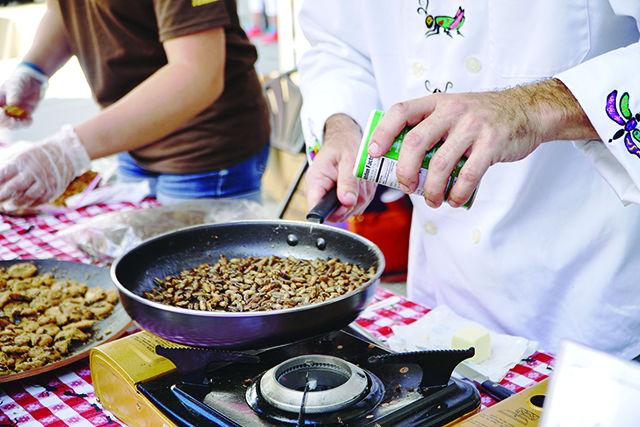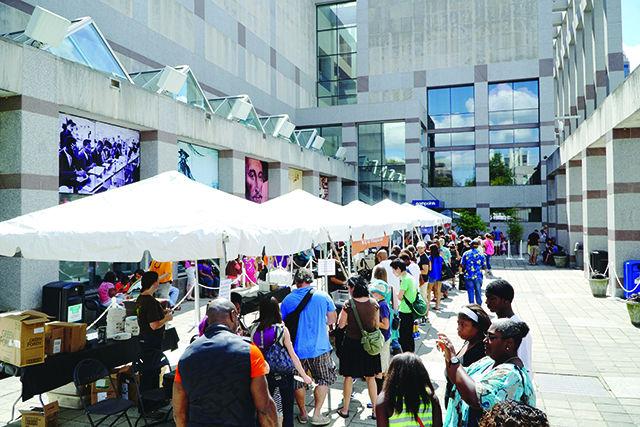The North Carolina Museum of Natural Sciences came to life Saturday as more than 35,000 visitors came to learn about, play with and eat insects at the annual BugFest.
Each year, the museum partners with NC State and other educational institutions to teach people of all ages about arthropods and their role in the environment. The event, which was held from 9 a.m. until 7 p.m. featured bug-themed exhibits, crafts, games and activities.
Kari Wouk, senior manager of presentations and partnerships at the museum, attributes the attraction to BugFest’s festival feel.
“BugFest has a festival flare to it,” Wouk said. “People come to just have fun, but we manage to reel them in and help them learn about bugs. They end up learning a ton about arthropods.”
Anything remotely related to insects was fair game at this weekend’s festival. Vintage Volkswagen vehicles were on display outside, including a replica of Herbie the Love Bug.
One event that drew a large crowd was the Roachingham 500, a cockroach race where human participants tried to predict the winner.
More than 115 booths lined Edenton and Wilmington streets, each with a unique educational experience. Representatives from NC State manned 20 of those booths.
NCSU Libraries and researchers from the biological sciences and entomology departments presented information at the festival. Other booths ranged from high school students providing bug games for children to play to Ph.D. researchers sharing their work in entomology.
Inside the Museum of Natural Sciences, the festival continued. Booths were set up throughout every inch of available space. Most of the booths were dedicated to presenting a specific insect. Visitors were able to learn about and hold insects such as praying mantises, butterflies and even cockroaches.
One of the more obscure attractions inside the museum was the “Mosquito Box Challenge,” where visitors stuck their arms inside a box of mosquitos and saw how long they could last.
This year’s BugFest theme featured a bug familiar to North Carolinians — the cicada.
The more than 1,400 volunteers at the event wore T-shirts with cicadas on them. There was even a sand sculpture replica of the cicada bug. Children participated in a scavenger hunt that involved finding hidden cicada shells throughout the museum.
The keynote speaker for the event was John Cooley, a postdoctoral researcher from the University of Connecticut and an expert on cicadas.
In his presentation, Cooley told visitors about the history of cicadas and their use in art and literature. He finished his speech with information about the cicada’s periodic migration cycle, explaining how this process will bring them back to North Carolina in 2017.
The highlight of the festival for many visitors was the Café Insecta. The Café featured several local restaurants and food trucks and gave patrons the opportunity to get a taste of entomophagy — the practice of eating bugs.
“Café Insecta prepares dishes for everyone to eat,” Wouk said. “We feed over 3,000 people bug-based dishes for free.”
The event kicked off on Friday with the Critter Cook-off. Two chefs participated in the competition. Each chef had 50 minutes to prepare a three-course meal that incorporated mealworms, superworms, crickets and cicadas.
The overall purpose of Café Insecta was to help demonstrate that bugs are a good, tasty source of protein with considerably less environmental impact than typical protein-rich foods. BugFest was founded based on the idea of Café Insecta.
“Nineteen years ago, an employee had the idea to cook bugs at a Halloween event and feed them to visitors,” Wouck said. “They had 2,000 people show up to the event, and it has grown and grown since then.”
BugFest carried on into the night during the Evening Insectival, with live bands and more activities for all the night crawlers who stuck around.
People wait in line for food with bug ingredients in front of the NC Museum of History during Bugfest on 9/19.









